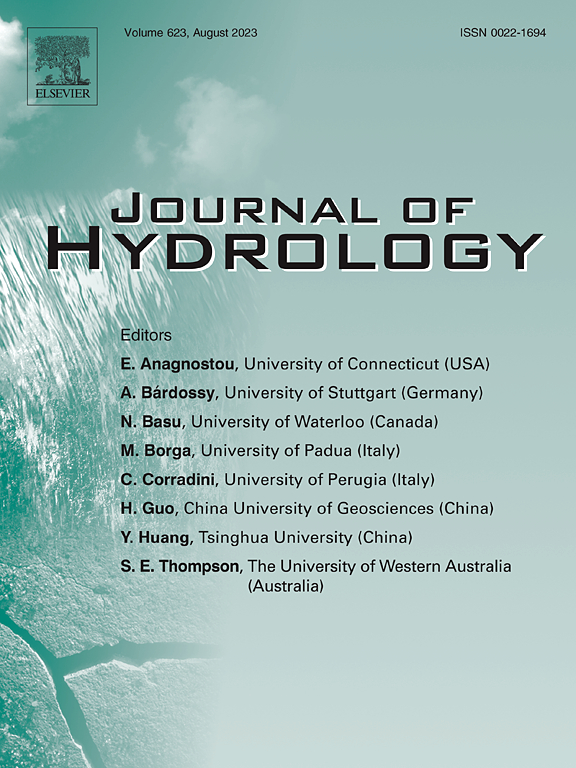The perspective of future climate warming impacts on harmful algae blooms in eutrophic Lake Taihu, China
IF 5.9
1区 地球科学
Q1 ENGINEERING, CIVIL
引用次数: 0
Abstract
Elevated water temperatures accelerate nutrient cycling and metabolism in aquatic ecosystems. Eutrophic waters, such as Lake Taihu, historically has been suffered from cyanobacterial (Microcystis spp.) blooms, exhibiting heightened sensitivity to climate change. Nevertheless, the quantitative responses of this highly productive lake to future warming remains poorly predicted. This study employes a three-dimensional hydrodynamic model coupling a lake thermal model and cyanobacterial biomass model to project future water temperatures and associated phytoplankton biomass in Lake Taihu under multiple Shared Socioeconomic Pathways (SSPs), comparing scenarios for 2100 against current conditions (2015–2022 multi-year average). Results indicate that annual mean Lake Water Column Temperature (LWCT) will rise by 1.12 °C, 2.15 °C, 4.18 °C, and 4.97 °C under respective SSP scenarios, which is much higher than the global average increase of inland waters. The most pronounced warming occurs during autumn, while winter thermal stratification stability is projected to decline (vertical temperature deviation approach zero). Algal bloom intensity (by chlorophyll-a concentration) is projected to increase by 12.0%, 22.2%, 46.2% and 62.5%, indicating that climate warming may trigger extensive and severe blooms in highly productive waters. Sensitivity analyses reveal that a 40% nutrient reduction effectively controls cyanobacterial concentrations during 2060–2090 in all but the warmest scenario. These findings demonstrate that targeted nutrient mitigation can counteract the amplifying effects of climate warming on cyanobacterial blooms in eutrophic waters.
未来气候变暖对富营养化太湖有害藻华影响的展望
水温升高加速了水生生态系统的营养循环和代谢。富营养化水域,如太湖,历史上一直遭受蓝藻(微囊藻属)的大量繁殖,表现出对气候变化的高度敏感性。然而,这个高产湖泊对未来变暖的定量反应仍然难以预测。本研究采用三维流体动力学模型耦合湖泊热模型和蓝藻生物量模型,预测了多种共享社会经济路径(ssp)下太湖未来水温和相关浮游植物生物量,并将2100年的情景与当前条件(2015-2022年多年平均值)进行了比较。结果表明:在SSP情景下,湖泊水柱温度(LWCT)年平均升高幅度分别为1.12、2.15、4.18和4.97°C,远高于全球内陆水域的平均升高幅度。增温最明显的是秋季,而冬季热分层稳定性预计将下降(垂直温度偏差接近于零)。藻华强度(按叶绿素-a浓度计算)预计分别增加12.0%、22.2%、46.2%和62.5%,表明气候变暖可能在高产水域引发广泛和严重的藻华。敏感性分析显示,在2060-2090年期间,除了最温暖的情景外,营养物质减少40%有效地控制了蓝藻浓度。这些发现表明,有针对性的营养缓解可以抵消气候变暖对富营养化水域蓝藻华的放大效应。
本文章由计算机程序翻译,如有差异,请以英文原文为准。
求助全文
约1分钟内获得全文
求助全文
来源期刊

Journal of Hydrology
地学-地球科学综合
CiteScore
11.00
自引率
12.50%
发文量
1309
审稿时长
7.5 months
期刊介绍:
The Journal of Hydrology publishes original research papers and comprehensive reviews in all the subfields of the hydrological sciences including water based management and policy issues that impact on economics and society. These comprise, but are not limited to the physical, chemical, biogeochemical, stochastic and systems aspects of surface and groundwater hydrology, hydrometeorology and hydrogeology. Relevant topics incorporating the insights and methodologies of disciplines such as climatology, water resource systems, hydraulics, agrohydrology, geomorphology, soil science, instrumentation and remote sensing, civil and environmental engineering are included. Social science perspectives on hydrological problems such as resource and ecological economics, environmental sociology, psychology and behavioural science, management and policy analysis are also invited. Multi-and interdisciplinary analyses of hydrological problems are within scope. The science published in the Journal of Hydrology is relevant to catchment scales rather than exclusively to a local scale or site.
 求助内容:
求助内容: 应助结果提醒方式:
应助结果提醒方式:


